Kinds
Plant based opiates:
- Morphine;
- Thebaine;
- Codeine.
Opiates of semi-synthetic origin:
- Heroin;
- Ethylmorphine;
- Hydromorphine;
- Dihydroxycodeine.
Synthetic:
- Methadone;
- Promedol;
- Tramadol;
- Fentaline.
Why are they dangerous?
If you are addicted to this group of drugs, the following dangers exist:
- High risk of contracting HIV, hepatitis, AIDS;
- Overdose resulting in death;
- Damage to the liver and kidneys;
- Decreased intellectual ability;
- Weakening of the immune system;
- Impotence;
- Tooth decay and vein disease.
Signs and consequences of opiate use
Heroin
Signs of heroin use:
- The addict seems to hang for several minutes or hours in one position;
- Labored breathing;
- Vomiting and nausea;
- Reduced brain and intellectual activity.
Consequences of heroin use:
- A person is driven by only one thing - he is constantly in search of the next dose;
- Suicidal thoughts, depression;
- Convulsions and seizures;
- Heart rhythm disturbances;
- High blood pressure.
Codeine
Signs of codeine consumption:
- Relaxation;
- Unreasonable euphoria;
- Carefree.
Consequences of using codeine:
- Strong apathy, indifference to everything;
- Heaviness in the limbs;
- Depressive state;
- Diarrhea;
- Convulsions;
- Severe headaches;
- Poor sleep;
- Pain in the heart and joints;
- Vomiting and nausea;
- Problems with the liver and gastrointestinal tract.
Morphine
Signs of morphine use:
- Constricted pupils and watery eyes with a reddish tint;
- Low temperature, chills may be replaced by high fever;
- Scars and ulcers at injection sites;
- Frequent constipation and diarrhea;
- Drowsiness, lethargy and apathy.
Consequences of morphine use:
- Weakening of the immune system;
- The occurrence of various diseases of the heart and lungs;
- Hepatitis and HIV;
- Death of brain cells;
- Deterioration of brain activity, a person is unable to think sensibly.
Opium
Signs of use:
- Neurological disorders and frequent yawning;
- Sharp and noticeable weight loss, the face becomes covered with wrinkles;
- Increased salivation;
- Mental abilities deteriorate;
- The drug addict constantly sneezes and has a runny nose;
- Tremor of the limbs, pain in the muscles, lower back, legs;
- Most drug addicts experience toothache and problems with the chewing muscles.
Consequences of opium use:
- Inhibited functioning of the respiratory center of the brain, resulting in respiratory arrest;
- Various purulent skin diseases;
- Problems with the liver, veins;
- Anxiety, constant depression;
- Frequent thoughts of suicide.
Symptoms of opium addiction: heroin
Heroin is a synthesis of morphine, which has a strong effect on the psychological state of a person. Heroin is taken by subcutaneous injection, smoking or inhalation. The drug is a powder that varies in color depending on how processed it is. On black markets it can be distributed mixed with sugar, flour, and starch. After using heroin in small quantities, a person feels:
- relaxation;
- euphoria;
- indifference to what is happening;
- apathy;
- Sometimes taking it can cause dizziness, vomiting, and tremors.
Having exceeded the heroin dose, a person’s blood pressure increases, arrhythmia and insomnia occur. With the systematic use of heroin, a person is both in an elevated mood and depressed. When taken orally, heroin powder damages organs, develops liver disease, and contributes to complete exhaustion of the body.
Opium muffles a person’s feelings and sensations, puts him into deep sleep, paralyzing all parts of the nerve endings and brain areas responsible for muscle movement. The pupils of such a person become very constricted and do not react to light. Sudden death may occur as a result of this condition. Heroin injections with one syringe are carriers of serious diseases such as AIDS, hepatitis C and B.
Stages of opioid addiction
Quite often, for almost every third person, the first try of opiate drugs is accompanied by not so pleasant sensations:
- Chills;
- Nausea and vomiting;
- Feeling hot;
- Severe dizziness;
- Headache.
However, even such an unsuccessful experience of trying this group of drugs does not become an obstacle to their subsequent use.
Initially, drugs are taken sporadically, usually in noisy groups. In this case, the dose does not change and remains the same. This stage can last for 2-3 months. Dependence on this type of drug develops most quickly when it is administered intravenously, as well as with frequent use of homemade poppy drugs. For example, addiction to heroin occurs after 3-5 intravenous injections, and addiction to morphine occurs after 10-15 injections.
First stage
At the first stage of opium addiction, persistent mental dependence is already fully formed, drugs are used systematically, and the first tolerance to the doses used appears. If the next dose is not taken on time, the drug addict will become irritable and depressed.
Second stage
The second stage occurs approximately 1-2 months after drugs have begun to be used systematically. Tolerance becomes stronger, and the addict constantly increases the dose. Even when consuming large portions of the drug, it is no longer possible to achieve the former euphoria. The addict begins to use the drug more and more often. At this stage, a clear formation of withdrawal syndrome occurs.
Third stage
The third stage is characterized by a complete absence of the euphoric effect of using the opiate, but the patient cannot refuse to take it, since he is not able to function without it. Long-term opiate addiction results in significant harm to most organs.
Features of opium addiction
Opium addiction manifests itself in the form of rapid heartbeat, loss of interest in everything that is happening, a dull look, drowsiness, and muscle weakness. The formation of withdrawal occurs gradually with complications and anxiety and depression. At the same time, you can observe dyspeptic disorders of the digestive tract, frequent urge to go to the toilet (up to 10 times a day), arrhythmia, and sweating. After struggling with withdrawal, the craving for drugs persists for a long time, and with it asthenia and apathy remain.
The effect of opiates on the body after taking them depends on the dosage of the substance and the method of administration. Drug intoxication occurs 8-15 minutes after injection and lasts from 3 to 5 hours. When taken as a tablet, the effect begins within half an hour.
Opium addiction is divided into 3 stages of intoxication:
- euphoria, excitement, heightened emotional background;
- intoxication, relaxation, frivolity;
- end of exposure, abstinence, apathy.
The euphoric state occurs in a period of 40 seconds. up to 5 min. When taking a narcotic substance intravenously, drug addicts feel a warm rush rising from the abdomen to the brain; a sore throat and skin irritation in the bridge of the nose and neck may appear.
Involuntary muscle tension increases, the reaction becomes monotonous, patients are unable to control uncontrollable laughter and gestures, the addict is in an extremely excited state. Self-esteem is elevated, early problems seem completely solvable, the world becomes brighter, plans, thoughts, and ideas appear. The inhaled drug does not cause such euphoria, and when taken orally, the skin turns red, swelling appears with a pleasant itching of the whole body.
What does an opiate overdose look like?
Heroin
In case of an overdose from heroin, the first signs can be observed within a few minutes after its injection into a vein. In this case, low blood pressure, confusion, and constipation are observed. The addict becomes very sleepy, and the mouth also becomes very dry. In some cases, nails and lips turn blue. Severe weakness is felt in the arms and legs. Slow movements and shallow breathing are observed.
It is necessary to especially highlight the following three symptoms that occur during a heroin overdose:
- Loss of consciousness;
- Depressed breathing;
- Narrow pupils that look like small dots.
If a drug addict exhibits this kind of symptoms, and this is easily determined by the presence of marks on the veins from injections, then the diagnosis should not raise any doubts.
It should also be noted that when dosing with heroin, a decrease in heart rate and a drop in blood pressure may occur. The skin takes on a pale and dry appearance. The main cause of death may be respiratory arrest; pulmonary edema and cardiac arrest are not excluded.
Almost every second heroin addict ends his short life with an overdose of this drug. This is explained by the fact that most drug addicts use heroin alone, choosing deserted places for this, that is, where they cannot be seen, and therefore there will be no one to help.
Codeine
Codeine addiction can result in severe addiction and overdose. In case of codeine overdose, the following symptoms are observed:
- Labored breathing;
- State of euphoria;
- Blueness of nails and lips;
- Weak pulse;
- Clammy and cold skin;
- Spasms of the intestines and stomach;
- Shiver;
- Epileptic seizures;
- Convulsions;
- Low blood pressure;
- Constricted pupils;
- Coma.
Some of the overdose symptoms listed above may be caused by an allergic reaction to the drug. If symptoms of a codeine overdose appear, you must immediately call an ambulance, otherwise everything could end badly.
Morphine
It should be noted that each person’s individual sensitivity to morphine may vary within different limits. For example, in an adult, with a single intravenous or subcutaneous use of 30 mg of this drug, an overdose can occur.
In case of morphine overdose, the main symptoms are the following:
- Depressed breathing;
- Miosis;
- Coma.
The first sign is a significant reduction in the size of the pupil, it becomes the size of a pinhead. However, the pupils can also dilate greatly against the background of severe hypoxia. The breathing rate decreases significantly, to approximately three to four breaths per minute. A drug addict who overdoses becomes cyanotic.
An overdose of this drug results in confusion of thinking and consciousness, a person can be in a complete stupor, and then, if proper measures are not taken, a coma occurs. Initially, blood pressure levels are normal, but as the degree of poisoning increases, they begin to gradually decrease, which subsequently results in a state of shock. The possibility of tachycardia, rhabdomyolysis, and bradycardia cannot be excluded.
In some cases, especially common in children and adolescents, muscle relaxation may occur, resulting in generalized seizures. The result of death, as a rule, is respiratory arrest or lack of oxygen, and the possibility of pulmonary edema is also possible.
Opium
An overdose of a drug such as opium is accompanied by drowsiness, which develops very rapidly. Quite often it happens that drug addicts go into a comatose state, such a state is very life-threatening, since it is very difficult or almost impossible to wake them up. When opium poisoning is too severe, the pupils stop responding to light, breathing is greatly impaired - it becomes hoarse, nervous, rare and difficult. In most cases, if the patient holds his breath for a long time, death or paralysis occurs. In such cases, every minute counts and there is no need to hesitate; you need to immediately take the drug addict to a drug treatment clinic, where professional intoxication of the body will be carried out. Only such a solution can pull a drug addict out of a comatose state and save his life.
Symptoms of opium addiction: methadone
Methadone is a narcotic substance that differs from heroin in its chemical structure, but has the same effect on the psyche and the human body. This substance affects the body for several days after consumption. Taking more than 50 grams of the substance provokes death.
Opium addiction is difficult to treat, and withdrawal symptoms are more severe and life-threatening. For therapeutic purposes, the substance can have a sedative effect on nerve receptors, reducing the load on the addict’s heart. The effect of the drug begins 20-30 minutes after its use.
Exceeding the permissible dose of methadone, you can experience slow breathing, changes in body temperature, nausea, vomiting, and in worst cases, pulmonary edema, kidney failure. Dependence on methadone develops over many years of use.
Methadone is used in the form of capsules and injections. With constant use of the substance, suffocation develops, the functioning of the gastrointestinal tract is disrupted, and hallucinations and nightmares occur more often. Frequent use of methadone results in death.









